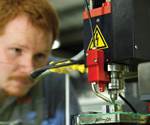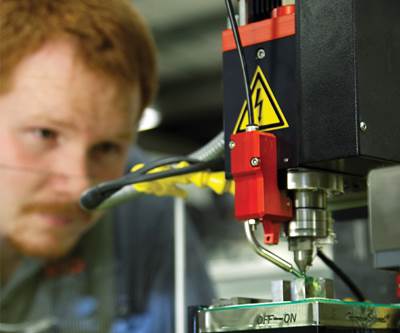Injection Mold Inc.
This shop specializes in rapid prototype molds and “quick-delivery” production molds.
How did you come to build primarily prototype molds?
Joe Vawter, Director of Sales: We are a small, family-run company producing 180 to 200 prototype molds per year for the medical, safety, appliance, electronics and automotive industries, among others. When my father started the company in 1979, we built only production molds, and it’s still about 10 percent of our business. We began serving mainly prototype customers about 15 years ago, because it’s a lot better cash flow. We had some ups and downs like most companies did due to trade agreements with China, Mexico and Canada, so my father, brother and I sat down and decided we needed to reinvest in the company to focus on building mainly production-quality prototype molds. Over time, this new market niche built itself up to be the main focus of our company.
How does building prototype molds differ from building production molds?
Injection Mold: While we build our prototype molds using the same equipment and processes we use for production molds, so our customers get production-quality parts, it’s quicker and easier to cut aluminum than it is to cut hardened tool steel. Also, some of the processes used for prototype molds are faster. For example, we don’t send prototype molds out to heat treat, whereas we do send out production molds and then recut them when they come back.
When you build a customer a production tool, that tool is something that shop will have to live with for a long time, so we spend more time in the design phase, making sure the tool will live up to its expectations for the life of the program. With prototype tooling, the customer’s main concern is getting a quality part in hand quickly. Also, the internal components of prototype designs are a little bit different than those of production molds. Customers typically specify “store-bought” components like slides or lifters for production molds so that they can be easily sourced and replaced wherever production is being run. It’s rare that components for prototype molds would need replacement, since they are not intended to make millions of parts, so these components are usually built in house, which saves time.
Personally speaking, the prototype market is much more interesting, because you’re always working on a brand-new product. Plus, the lead times are short, so you’re not working on the same project for a long period. A production mold may take eight to 10 weeks to complete, while in that same amount of time we’ve built 20 to 25 prototype molds.
What sets your company apart from the competition?
Injection Mold: If you took a part made from one of our prototype molds and laid it beside a part made from the corresponding production tool, you could not tell the difference. This is because we provide our customers with the exact design they ask for. Some other prototype houses ask customers to change designs to meet their processes.
One recent project was for a customer that wanted parts for a fast-approaching trade show. There had been some setbacks in the design phase, which of course put the whole project in jeopardy of not being ready for the show. The parts involved were complex, and the tooling required a lot of side actions. The customer came to us because a competitor wanted that shop to simplify the design of the parts to make them easier to produce. Not only were we able to meet the customer’s complex part requirements, we had parts in that customer’s hands ahead of schedule.
We can do this because, unlike many prototype houses, we have a fully equipped shop, including high-speed machining centers (three- and five-axis), CNC EDMs, as well as the whole gamut of equipment that production mold shops have, but we offer that as a prototype service. Every prototype mold is built from higher grades of aluminum, making them more durable, and we also finish the mold surfaces, including polishing the cavities and cores.
Additionally, we offer injection molding in house. Our molding facility is equipped with five all-electric Toshiba molding presses with capacities ranging from 85 tons to 390 tons. Some of the prototype molds we build may only make 25 parts, and that might be the life of the program. However, it’s not unusual for us to mold as many as 200,000 parts with some of our molds, which is not so common in most other prototype houses. Customers will often request a quantity of prototype parts in order to get them to market faster while they build the actual production tooling. Several of our customers have taken first shots molded from our prototype molds and used them in assemblies that then went to market.
Do you design molds in house? How do you work with customers on design?
Injection Mold: Everything we build, we design internally. We have three designers who use Unigraphics for CAD, and our programmers work in WorkNC by Vero Software and Mastercam / CNC Software. Our customers supply us with 3D CAD models, and their molds are designed based on the models. Fast-turnaround prototype molds are not conducive to having milestone meetings or preparing detailed progress reports. Instead, once a job is approved, our team gets to work and the customer is informed of the job’s progress almost daily to ensure the parts are in the customer’s hands by the promised delivery date. At times, we may finish a job early, and staying in daily contact helps the customer plan for that as well.
Related Content
Five-Axis Graphite Mill With Automation Debottlenecks Electrode Machining
Five-axis electrode cutting enabled Preferred Tool to EDM complex internal screw geometry on an insert that otherwise would have had to be outsourced.
Read MoreLaser Welder Yields Fast, Precise Mold Repair
Intralox's integration of the Alpha Laser ALFlak has significantly improved their tool room efficiency when it comes to difficult welds and urgent repairs.
Read MoreIntegrated CAD/CAM Streamlines Electrode Manufacture, Improves Quality
A focus on electrode design and automation helps toolroom improve efficiency, reduce tooling costs and deliver higher quality products.
Read MoreHow to Achieve Unmatched Accuracy in Very Large Workpieces
Dynamic Tool Corp. purchases two bridge-style double-column CNCs to increase the cutting envelope and maintain 5-micron cutting accuracy in the long term.
Read MoreRead Next
MTD Micro Molding
This shop specializes in building molds for tiny parts with such complexities as 0.1-mm walls, 0.025-mm corner radii and holes as small as 0.051 mm in diameter.
Read MoreAre You a Moldmaker Considering 3D Printing? Consider the 3D Printing Workshop at NPE2024
Presentations will cover 3D printing for mold tooling, material innovation, product development, bridge production and full-scale, high-volume additive manufacturing.
Read MoreHow to Use Strategic Planning Tools, Data to Manage the Human Side of Business
Q&A with Marion Wells, MMT EAB member and founder of Human Asset Management.
Read More




















